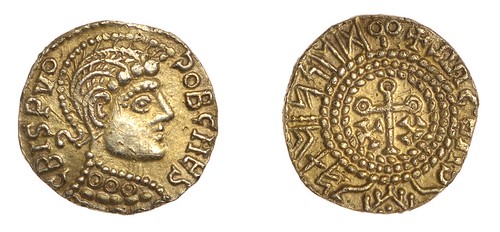
PREV ARTICLE
NEXT ARTICLE
FULL ISSUE
PREV FULL ISSUE
V25 2022 INDEX E-SYLUM ARCHIVE DIX NOONAN WEBB OFFERS RARE GOLD THRYSMAThis Dix Noonan Webb press release recounts the discovery of a rare gold shilling. -Editor It was on Monday, January 3, 2022 that 55-year-old drainage engineer, Mark Pallett, decided to search a stubble field, which he has been to many times before, with his Minelab Equinox 800 at Haslingfield in South Cambridgeshire. After just 15 minutes of being on the field, Mark got a faint signal and digging down only four inches discovered what he thought was a small button with a cross in the centre. To start off with, he didn't think that the coin was real, but upon turning it over he saw the image of a helmeted male bust and realised this was something very special. He was shaking so much, he couldn't believe what he had found, showed it to his friends and put it safely in his pocket. Identified as a gold shilling or thrymsa dating from 650-70 AD, it is to be offered by Dix Noonan Webb in their auction of Coins, Tokens and Historical Medals on Tuesday & Wednesday, March 8 & 9, 2022 at their Mayfair saleroom (16 Bolton Street, London W1J 8BQ). Measuring just 13 millimetres in diameter and weighing 1.3 grams, it is expected to fetch £8,000-10,000.
During his 38 years of detecting, father-of-three Mark, who lives in Brentwood in Essex, has
concluded that his best finds always turn up in the first two weeks of January, and on this
occasion he again knew he was about to find gold. As Mark says:
As Nigel Mills, Consultant (Artefacts and Antiquities) at Dix Noonan Webb explains:
He goes on:
He finishes:
For more information, see:
Wayne Homren, Editor The Numismatic Bibliomania Society is a non-profit organization promoting numismatic literature. See our web site at coinbooks.org. To submit items for publication in The E-Sylum, write to the Editor at this address: whomren@gmail.com To subscribe go to: https://my.binhost.com/lists/listinfo/esylum All Rights Reserved. NBS Home Page Contact the NBS webmaster 
|

